By Phil Bergman
General information and notes about my experience with palms native to New Caledonia.
(Please note that the following article was written about six years ago and updated since then. Recent publications have changed some names, so this presentation may be in conflict with the most recent nomenclature. (please see newly released work by Hodel et al., Palms of New Caledonia.)
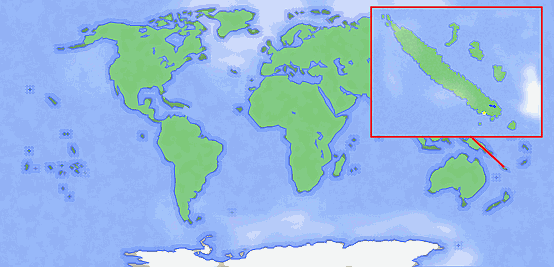
I’ve had great fun growing the New Caledonia palm species, what with their typically thick, leathery foliage, beautiful crown shafts and often red emergent new leaves. They are indeed quite striking and beautiful, all seeming different from the next. Also, because many species are quite difficult to obtain, I have had a fascination with these palms. However, even on distributed seeds, there has sometimes been confusion over true identification of species. This can lead to a condition of the blind leading the blind, a phenomena well known and experienced with Madagascar species. Also, as a general class of palms, many New Caledonian species are difficult to grow because of their very slow growth rates. Comments below are directed toward cultural aspects of these species. Hopefully this will give you an idea of what you can grow.
Plant Species
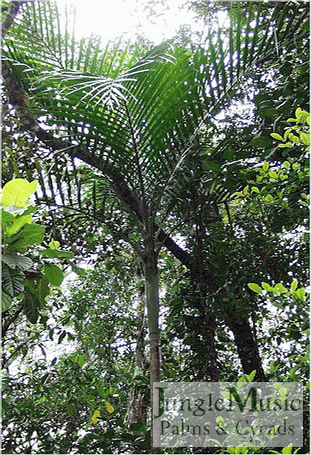
General comments about the species (or genera) I’ve grown include:
Actinokentia divaricata
Fair germination rates, slow growing in pots and in the garden, cold hardy to 28 degrees. Like filtered light. 8 year old plant in the ground is 3 feet tall.

Alloschmidtia glabrata
Irregular germination, extremely slow from seedling, less cold tolerance than other species but seems to survive my Coastal weather during the winter. Needs protection.

Basselinia species
Low to medium germination rates; unbelievably slow as seedling; faster with size; cold hardy to low 30s; like protected location with filtered light.
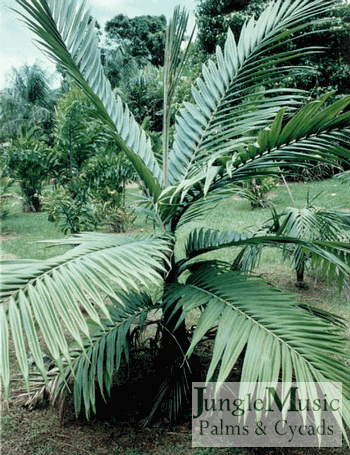
Burretiokentia hapala, vieillardii, other species nova
Fair to good germination rates, medium growth rate from seedling; like morning sun or filtered light; cold hardy to 28 degrees. In the greenhouse we grow seedling to 15g size in 5 years. One of the more promising of the N.C. palm genera.
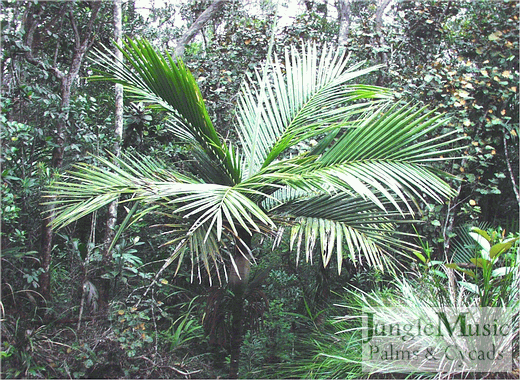
Campecarpus
Only had seeds twice; extremely low germination rates; difficult to grow as seedling and extremely slow; no experience with larger plants
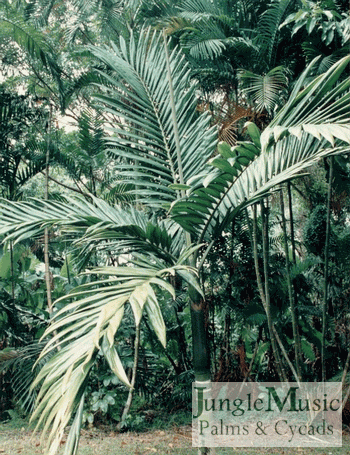
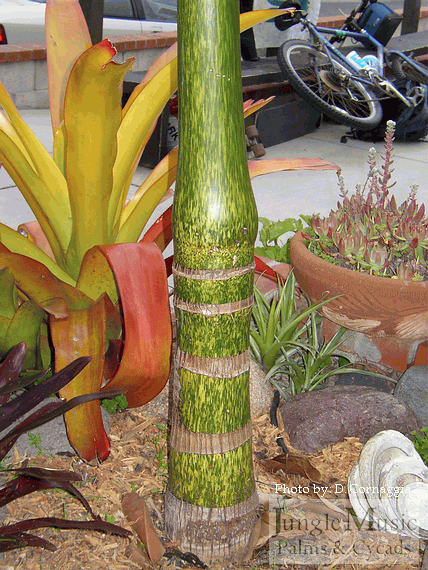
Chambeyronia macrocarpa, hookeri
Easy to germinate, quick growth from seedlings, slower as larger plant; in the garden two feet of trunk in ten years; like AM sun or strong filtered light, possibly full sun in Coastal areas; cold tolerant to 28 degrees. For the novice, these two are the easiest species. Some authorities deny the difference between the two species, but distinct morphological differences on growing them in the nursery and garden.
Another intersting thing about Chambeyronia is the development of the “watermelon trunk”. It’s quit common and not a species characteristic. We see it in about half of the Chambeyronia we propagate. See photo to left showing this “watermelon” look to the trunk.

Chambeyronia lepidota
Erratic germination, extremely slow as seedling; 5 year old plants are 2 gallon size; have a tendency to damp off; unsure about cold tolerance in the long term, but probably tolerant to low 30s. This is a small seeded species, unlike other Chambeyronias, possibly questioning its identity.
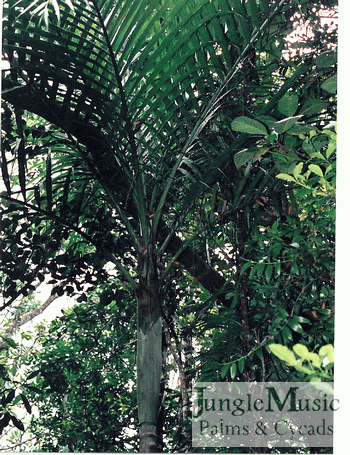
Cyphokentia macrostachys
Erratic germination, difficult as seedling, very slow growing. Feel privileged if you have one.
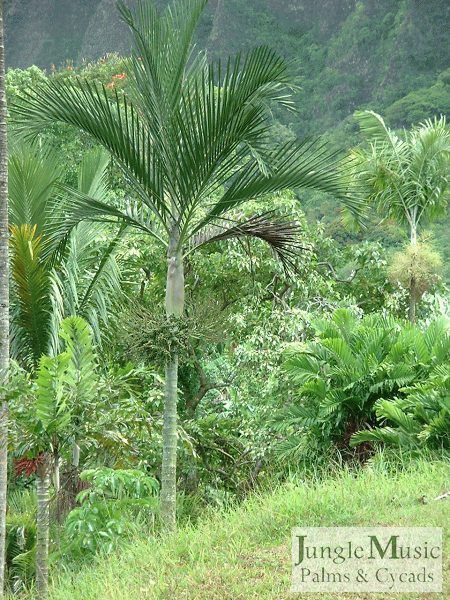
Cyhphophoenix nucelle, elegans
Medium germination rates if fresh seeds, slow as seedling, better growth rates as plant gets bigger; like filtered light; cold tolerance into the low 30s.
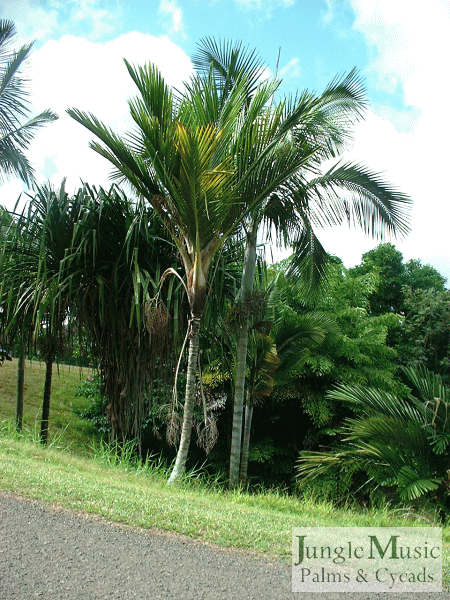
Cyphosperma balanse
Medium germination rates, slow as seedling; definite tendency to damp off as seedling, although somewhat better grower as the plant gets larger; likes filtered light; cold hardy to low 30s.

Kentiopsis oliveformis, nova
Extremely low germination rates (typically one per 100 seeds); slow to germinate and may take over 12 months, sometimes coming in small waves of germinating seeds; extremely slow as seedling, picking up speed when to one gallon size; likes strong filtered light or sun in Coastal area; cold tolerant to 28 degrees.
Maackea magnifica, others
Fair germination rates; slow as seedling; filtered light; cold tolerant to low 30s.
Mackea magnifica,
champagne stem
Gorgeous plant, although uncertain identity; it is speculated that this species is actually Kentiopsis piersoniorum. It is slow as seedling, slow as juvenile plant; good for outdoors here; tolerates low 30s; doesn’t like hot weather; likes strong filtered light, or partial full sun.
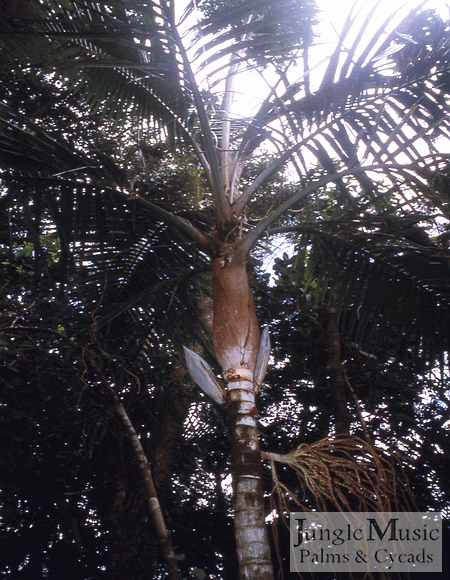
Vellonia alba: erratic germination
Slow as seedling, picks up growth rate as gets larger; cold hardy low 30s; likes filtered light .
Summary
Almost all species are gorgeous. Identification of some species is unsure. Most are difficult to obtain. The rarest species are rare because of limited seed sources and because of difficulties in germination and growth as a seedling. Most are extremely slow growing, a few moderately slow. Burretiokentia and Chambeyronia (not lepidota) are the fastest and easiest to grow. If you want them in your garden, be prepared to start with a small plant and to be patient on most species. Most like filtered light, some possibly full sun in Coastal areas. Most can survive non-freezing weather in Southern California.
ADDENDUM 2011: Author Don Hodel has recently revised the names of the palms of New Caledonia. We are going to edit this article to reflect these names in the near future, but for now will keep them as is. The new names are not widely recognized as of yet.
- PALM TREES, CYCADS & TROPICAL PLANT BLOG - October 1, 2020
- TRACHYCARPUS
The Windmill Palm - September 30, 2020 - FAN PALMS –
PALMS WITH CIRCULAR LEAVES - September 29, 2020












